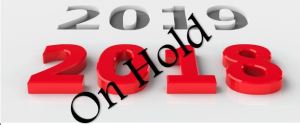 In case you hadn’t heard Congress is working on a tax bill! Yes, a bit snarky there. But this new tax bill does have a direct effect on payroll, especially our year end and year beginning updates. Normally by now we would have received the Notice that gives us the 2018 tax charts, the Form W-4 would have been finalized etc. But we were notified in the monthly IRS payroll industry phone conference call, on Thursday Dec. 7, that these items are on hold until the tax bill is passed or abandoned. Now since it is unlikely this bill will just be abandoned, the massive changes to tax charts, taxing of fringe benefits etc. is going to require extensive updates for the IRS to incorporate. So even if the bill is effective January 1, 2018, which it is indicated to be, don’t expect the new charts immediately. The IRS needs time to “review and implement” the required changes. So what will probably happen is that we will have an “implementation period” as we did in 2009, when new tax legislation was passed. Employers will continue to use the 2017 charts and guidance until the info is received. This may pose a problem as many of the fringe benefits that we currently offer such as transportation passes, educational assistance and relocation may have tax status changes from nontaxable to taxable. So be sure to track these payments or benefits so they can properly taxed if need be when the final bill is implemented.
In case you hadn’t heard Congress is working on a tax bill! Yes, a bit snarky there. But this new tax bill does have a direct effect on payroll, especially our year end and year beginning updates. Normally by now we would have received the Notice that gives us the 2018 tax charts, the Form W-4 would have been finalized etc. But we were notified in the monthly IRS payroll industry phone conference call, on Thursday Dec. 7, that these items are on hold until the tax bill is passed or abandoned. Now since it is unlikely this bill will just be abandoned, the massive changes to tax charts, taxing of fringe benefits etc. is going to require extensive updates for the IRS to incorporate. So even if the bill is effective January 1, 2018, which it is indicated to be, don’t expect the new charts immediately. The IRS needs time to “review and implement” the required changes. So what will probably happen is that we will have an “implementation period” as we did in 2009, when new tax legislation was passed. Employers will continue to use the 2017 charts and guidance until the info is received. This may pose a problem as many of the fringe benefits that we currently offer such as transportation passes, educational assistance and relocation may have tax status changes from nontaxable to taxable. So be sure to track these payments or benefits so they can properly taxed if need be when the final bill is implemented.
Fringe Benefits taxation
Tips vs Service Charges: An IRS Reminder
The IRS wants to make sure that employers understand tax ramifications of the various payments that they make to employees or that their employees might receive. So the IRS has posted a reminder for employers when it comes to tips verses service charges. The key difference between the two categories affect the taxation for employees as well as the reporting. So-called “automatic gratuities” and any amount imposed on the customer by the employer are service charges, not tips. Service charges are generally wages, and they are reported to the employee and the IRS in a manner similar to other wages. On the other hand, special rules apply to both employers and employees for reporting tips. Employers should make sure they know the difference and how they report each to the IRS.
 What are tips? Tips are discretionary (optional or extra) payments determined by a customer that employees receive from customers. They include:
What are tips? Tips are discretionary (optional or extra) payments determined by a customer that employees receive from customers. They include:
- Cash tips received directly from customers.
- Tips from customers who leave a tip through electronic settlement or payment. This includes a credit card, debit card, gift card, or any other electronic payment method.
- The value of any noncash tips, such as tickets, or other items of value.
- Tip amounts received from other employees paid out through tip pools or tip splitting, or other formal or informal tip sharing arrangements.
Four factors are used to determine whether a payment qualifies as a tip. Normally, all four must apply. To be a tip:
- The payment must be made free from compulsion;
- The customer must have the unrestricted right to determine the amount;
- The payment should not be the subject of negotiations or dictated by employer policy; and
- Generally, the customer has the right to determine who receives the payment.
If any one of these doesn’t apply, the payment is likely a service charge.
What are service charges? Amounts an employer requires a customer to pay are service charges. This is true even if the employer or employee calls the payment a tip or gratuity. Examples of service charges commonly added to a customer’s check include:
- Large dining party automatic gratuity
- Banquet event fee
- Cruise trip package fee
- Hotel room service charge
- Bottle service charge (nightclubs, restaurants)
Generally, service charges are reported as non-tip wages paid to the employee. Some employers keep a portion of the service charges. Only the amounts distributed to employees are non-tip wages to those employees.
All cash tips and noncash tips should be included in an employee’s gross income and subject to federal income taxes.ployers are required to retain employee tip reports, withhold income taxes and the employee share of Social Security and Medicare taxes from the wages paid, and withhold income taxes and the employee share of Social Security and Medicare taxes on reported tips from wages (other than tips) or from other funds provided by the employee. In addition, employers are required to pay the employer share of Social Security and Medicare taxes based on the total wages paid to tipped employees as well as the reported tip income. Employers must report income tax and Social Security and Medicare taxes withheld from their employees’ wages, along with the employer share of Social Security and Medicare taxes, on Form 941, Employer’s Quarterly Federal Tax Return, and deposit these taxes in accordance with federal tax deposit requirements.Tips reported to the employer by the employee must be included in Box 1 (Wages, tips, other compensation), Box 5 (Medicare wages and tips), and Box 7 (Social Security tips) of the employee’s Form W-2, Wage and Tax Statement. Enter the amount of any uncollected social security tax and Medicare tax in Box 12 of Form W-2. See the General Instructions for Forms W-2 and W-3.
Reporting Service Charges: Employers who distribute service charges to employees should treat them the same as regular wages for tax withholding and filing requirements, as provided in Publication 15, Employer’s Tax Guide. Distributed service charges must be included in Box 1 (Wages, tips, other compensation), Box 3 (Social Security wages), and Box 5 (Medicare wages and tips) of the employee’s Form W-2.
Keep up to date with the latest from the IRS on taxation by subscribing to Payroll 24/7 today.
White Paper for the Month: Educational Assistance
My white paper for September is on educational assistance. How to properly track and tax this benefit is paramount to ensure compliance. Hope you find it useful.
white-paper-educational-assistance-2016
Beginning in October we will go back to more frequent white papers. We do them monthly during the summer as it is usually a slow time of the year for payroll and we all want to enjoy the summer off. But as year end begins to approach we will be focusing our white papers on preparing for it.
Speaking of year end…don’t get left out in the cold when it comes to critical year end news updates. Subscribe to The Payroll Pause today. Get all the latest payroll news as it is released, including wage bases, rates, and annual updates for the low price of only $149 per year. This type of news update service usually costs payroll departments $500 or more per year. But payroll news should not be out of the reach of all payroll professionals.
ATTENTION BLOG FOLLOWERS!: To reward my blog followers I am offering a special discount on a year’s subscription to The Payroll Pause. Only $99 per year (rate lasts as long as you keep your subscription current). That is a $50 savings! But act fast as this discount is just for the fall and will expire on October 15th. Use coupon code X36AK67F3 when checking out to receive the discount.
White Paper: Disaster Payments and the IRS
We are always hearing in the news about the latest disaster in the nation. Whether it be wild fires in California or flooding in Texas. Natural disasters do happen and can be annual occurrences in some parts of the nation. When this happens, it is natural to want to help those individuals who are personally affected especially if it strikes close to home like in the case of a co-worker. When a co-worker loses a home to a wild fire or must move out due to flood damage even employers want to help out. But when an employer wants to help, does that change the nature of the  assistance. In other words, if co-workers take up a collection it is one thing, but what if the employer gives the employee a grant to help cover the costs not reimbursed by insurance? Is it then taxable income and taxes must be deducted? Actually, it may not have to be. Our white paper this time is on Handling Disaster Relief Payments in Payroll. It explains how and when these types of payments can be made and the taxation requirements. We hope you find it useful.
assistance. In other words, if co-workers take up a collection it is one thing, but what if the employer gives the employee a grant to help cover the costs not reimbursed by insurance? Is it then taxable income and taxes must be deducted? Actually, it may not have to be. Our white paper this time is on Handling Disaster Relief Payments in Payroll. It explains how and when these types of payments can be made and the taxation requirements. We hope you find it useful.
white paper disaster payments 2016
Get the latest payroll-related news as it happens! Subscribe to The Payroll Pause today!
White Paper: If I use the gym is it taxable?
Our latest white paper deals with athletic facilities. It is very common for employers to offer wellness programs to get or keep employees fit and healthy. Employers may offer the use of an onsite athletic facility or they may purchase gym memberships outright or subsidize a portion of the annual fee. No matter what is offered the taxability has to be determined to ensure compliance. It basically boils down to is the gym onsite or off. Onsite athletic facilities are normally nontaxable if the employee can use it before work, during work or after work. Memberships purchased outright or even subsidized are generally taxable income to the employee.
This Week’s White Paper–Employee Achievement Awards
Taxing awards to employees is always a tricky business. Is it taxable or not? If I take taxes out will that diminish the award or the employee’s moral over receiving it? Unfortunately, we sometimes can’t take that into consideration. The IRS says it is taxable, so we tax. But sometimes the IRS says it is not taxable. Case in point, employee achievement awards. Given for length of service or safety, these awards can be given without adding it as income to the employee’s wages if done correctly. Of course, no cash or gift certificates. It must be tangible personal property like a pin for years of service or a plaque for safety. Our white paper this week deals with when to tax and when not to tax employee achievement awards. We hope you find the information useful. You can request your copy of our white paper on our website.
Get all the latest payroll news right to your inbox for a fraction of the costs of other news services! Subscribe to The Payroll Pause today! As our thank you gift for subscribing, receive attendance to one of our upcoming 2016 webinars for FREE! A $149 value free as our thank you for subscribing. But hurry, this promotion won’t last long.
Company Cars Part 2
Our free white paper this week is the second of our two-parter on the personal use of a company car. This time we are doing the math. Yes unfortunately, math is involved when having to determine the taxable wages. But it is not the only thing needed to do the computations. Vehicle values and vehicle logs are also needed, depending on the method chosen. You also need to determine the proper method based on the value of the car and the status of the employee. We hope you find the white paper useful. It can be requested on our website.
Subscribe to The Payroll Pause for all the latest payroll news right when you need it, right where you need it, in your inbox. Only $95 per year. Subscribe today!
Taxation of Wellness Programs
The Office of Chief Counsel of the Internal Revenue Service has issued a memorandum on “Tax Treatment of Wellness Program Benefits and Employer Reimbursement of Premiums Provided Pre-tax Under a Section 125 Cafeteria Plan”. Not quite a catchy title I admit but it does contain guidance that is useful. The two questions that were at issue are as follows:
- May an employer exclude from an employee’s income under section 105 or section 106 cash rewards paid to an employee for participating in a wellness program?
- May an employer exclude from an employee’s income under section 105 or section 106 reimbursements of premiums for participating in a wellness program if the premiums for the wellness program were originally made by salary reduction through a section 125 cafeteria plan?
The conclusion reached by the Chief Counsel was no on both counts. 1. An employer may not exclude from an employee’s gross income payments of cash rewards for participating in a wellness program. 2. An employer may not exclude from an employee’s gross income reimbursements of premiums for participating in a wellness program if the premiums for the wellness program were originally made by salary reduction through a section 125 cafeteria plan.
For those of you who need to research this closer I included the link to the memorandum issued on April 14, 2016 and released on May 27, 2016. They review three different situations and then provide the law and analysis you may need if this affects any benefits you are offering.
Last chance to register for early-bird pricing for our next webinar How to Finally Write Those Payroll Procedures. Early-bird pricing of only $99 ends at 5pm PDT today.
This Week’s White Paper-Personal Use of a Company Car Part 1
A common benefit in many U.S. companies today is the use of a company owned car. However, though a common benefit, an employee’s personal use of such a company owned and provided vehicle is generally a taxable fringe benefit and the taxation regulations can be extremely complex. The IRS provides several different valuation methods that employers can use to determine the value of their employee’s personal use. This two-part white paper discusses the taxation requirements and the different methods to determine taxable wages authorized by the IRS for the personal use of a company car. This week, Part one discusses the general taxation and other requirements when an employee has use of a company car. Next week, Part two discusses calculating the taxable wages using the IRS methods. To request our white papers simply go to our website.

